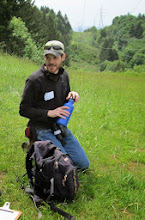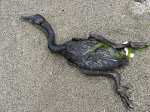 The weather changed by the minute from snow to rain to hail to warm sun and back to snow again.
The weather changed by the minute from snow to rain to hail to warm sun and back to snow again. Andie was eager to hit the beach regardless of the weather!
Andie was eager to hit the beach regardless of the weather!We conduct volunteer beached bird surveys at two beaches near Pacific City. We walk a mile of each beach to count, identify, measure, and tag the birds we find. On Saturday, we were accompanied by Sarah's cousin Sydney and her friend Alex. They helped us find 19 dead northern fulmars, one common murre, two short-tailed shearwaters, and one fork-tailed storm petrel wing.
 At the end of our mile, we found six bird in the same area, so we lined them up and processed them as fast as possible. Our exhausted assistant can be seen on the right edge of the photo.
At the end of our mile, we found six bird in the same area, so we lined them up and processed them as fast as possible. Our exhausted assistant can be seen on the right edge of the photo.Northern fulmars appear to be having a hard time surviving at sea, as they were washing up all over the place. An alternative explanation for the high body count is that fulmar populations have a constant mortality rate and a higher than normal number of birds are wintering off the coast, resulting in all the birds we find. This question arises each winter when large numbers of a seabird species are found washed up on Oregon beaches.
I found a few other interesting birds as well, including a horned grebe in transition plumage and a breeding plumaged pigeon guillemot.
 The foot color of the guillemot was an indescribably intense orange-red.
The foot color of the guillemot was an indescribably intense orange-red.We saw and heard plenty of live birds as well, most notably rufous hummingbirds that were buzzing around and nearly colliding with us everywhere we went. Other new arrivals include turkey vultures and violet-green swallows. Wintering cackling geese and buffleheads remained, adding to a great bird diversity and activity this time of the year.






No comments:
Post a Comment